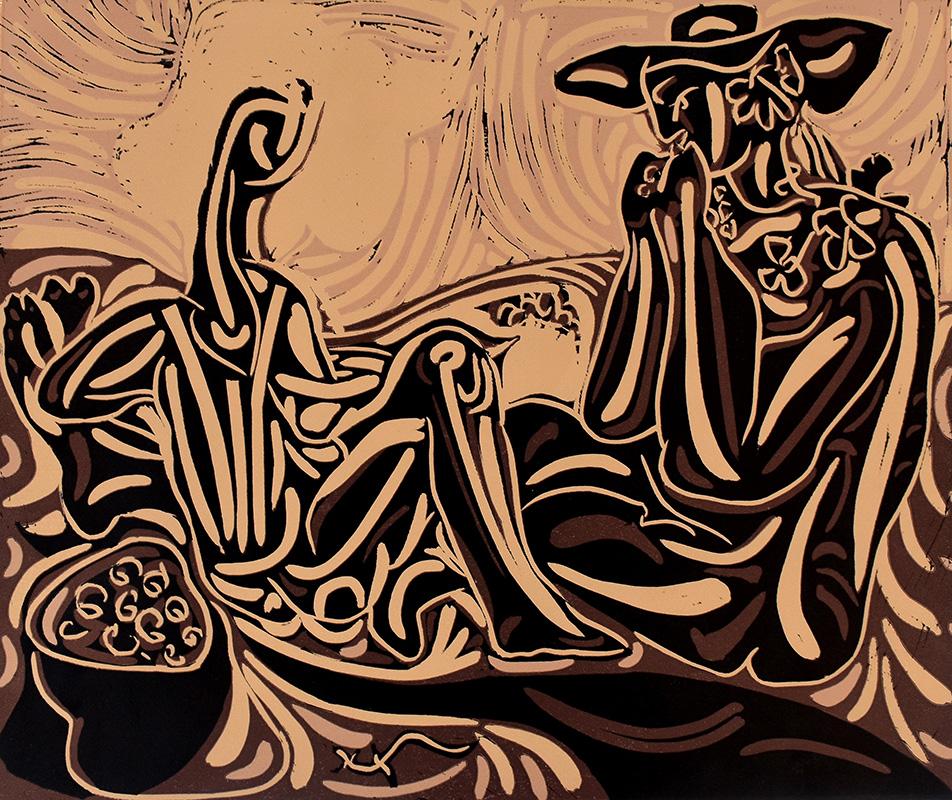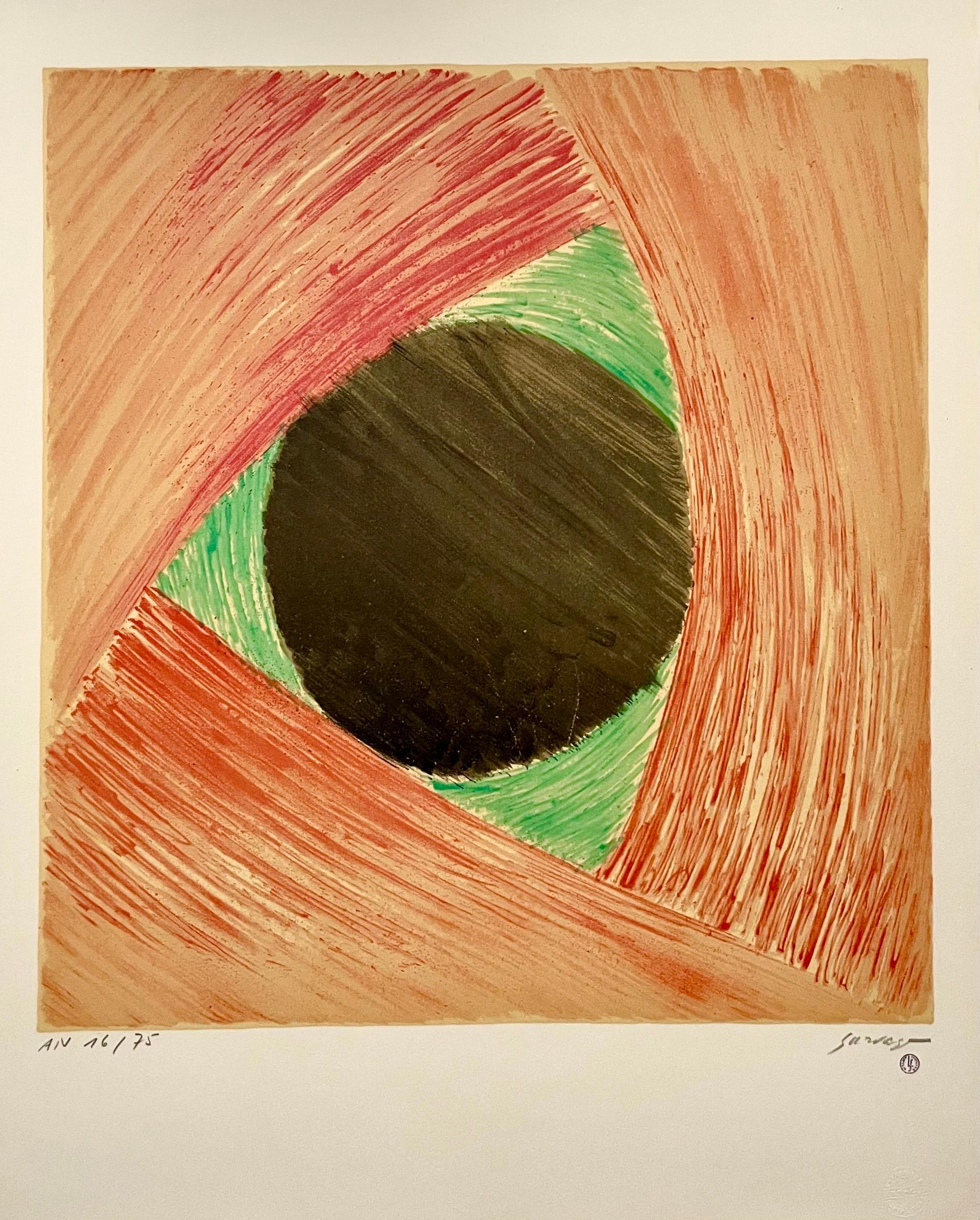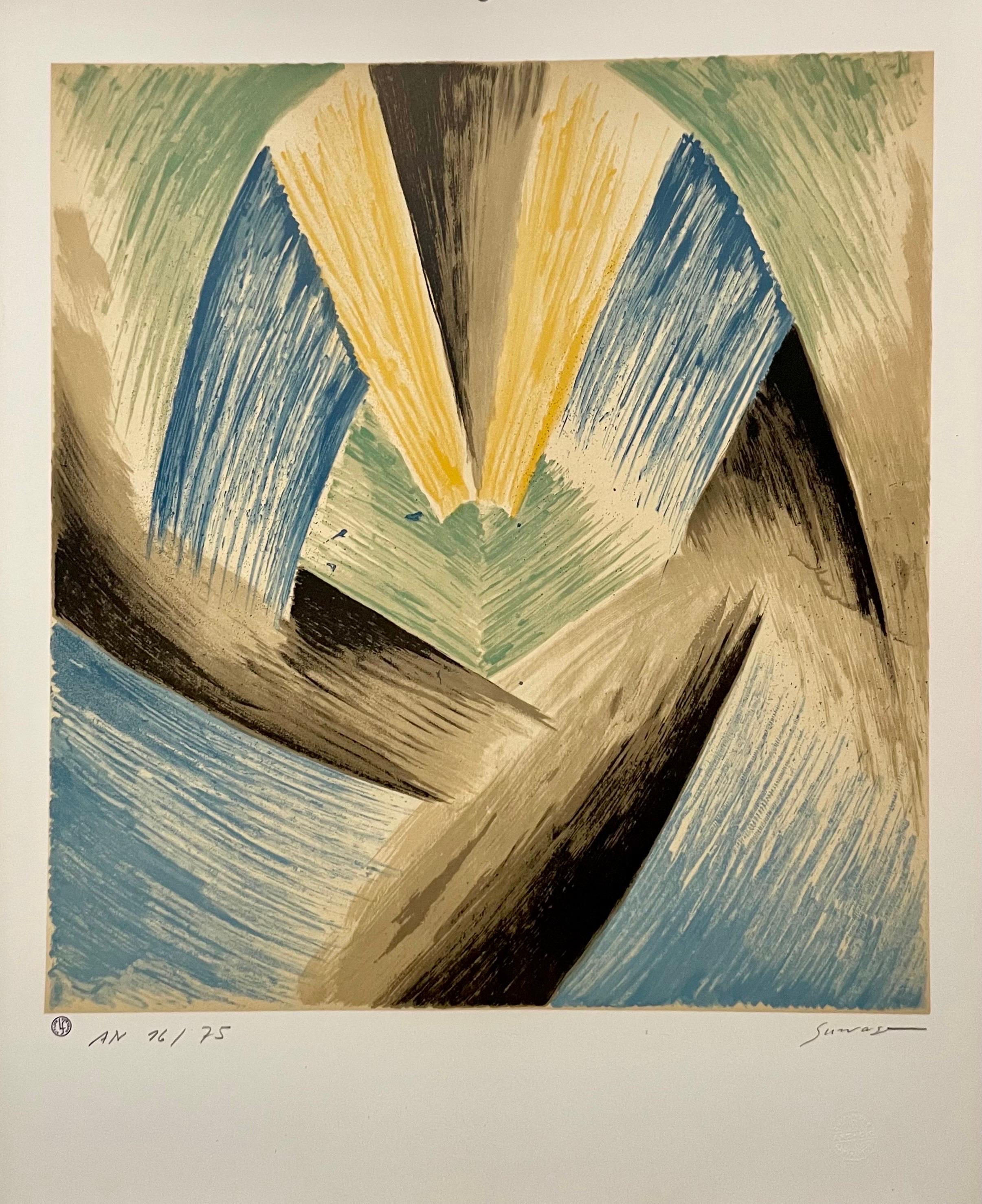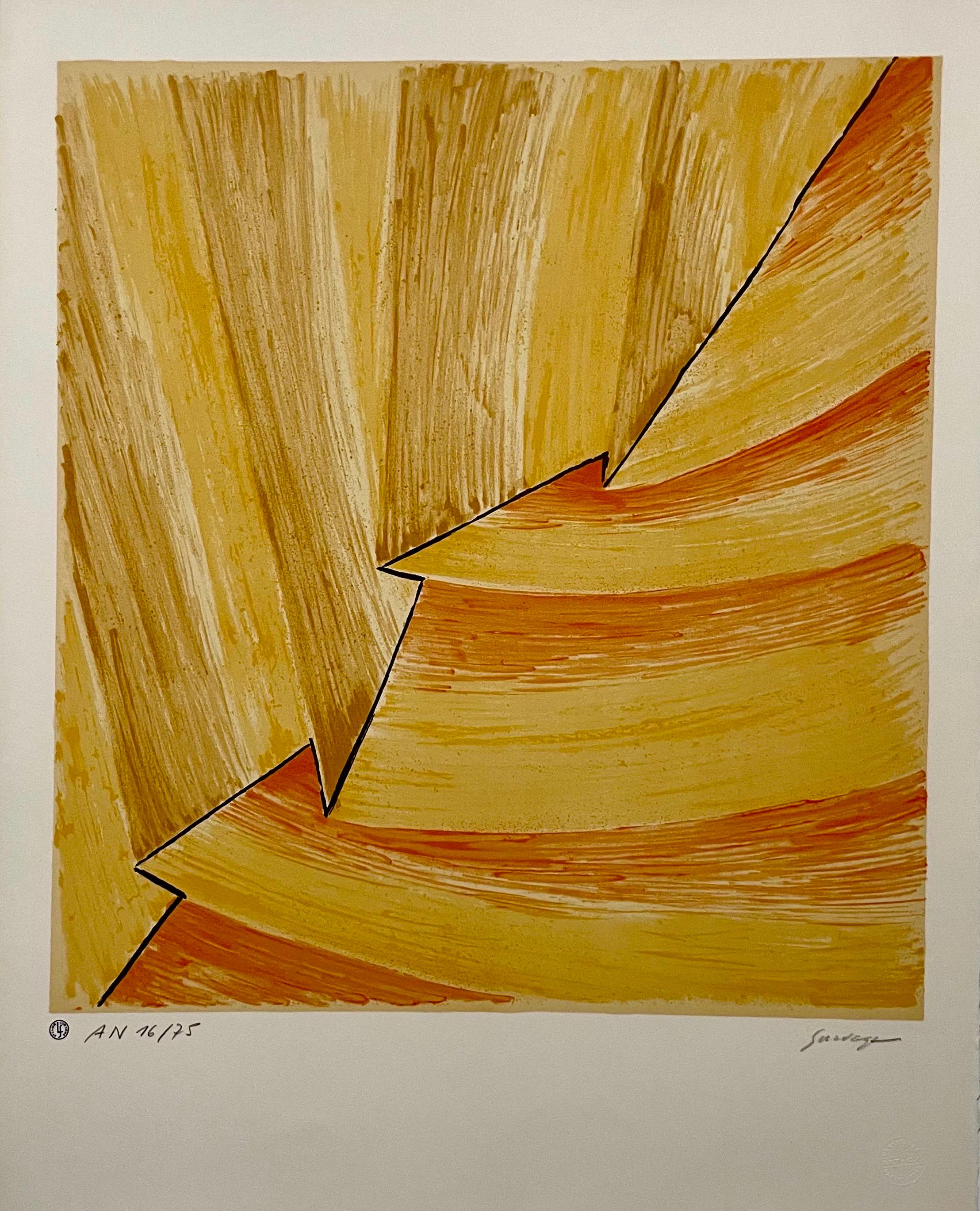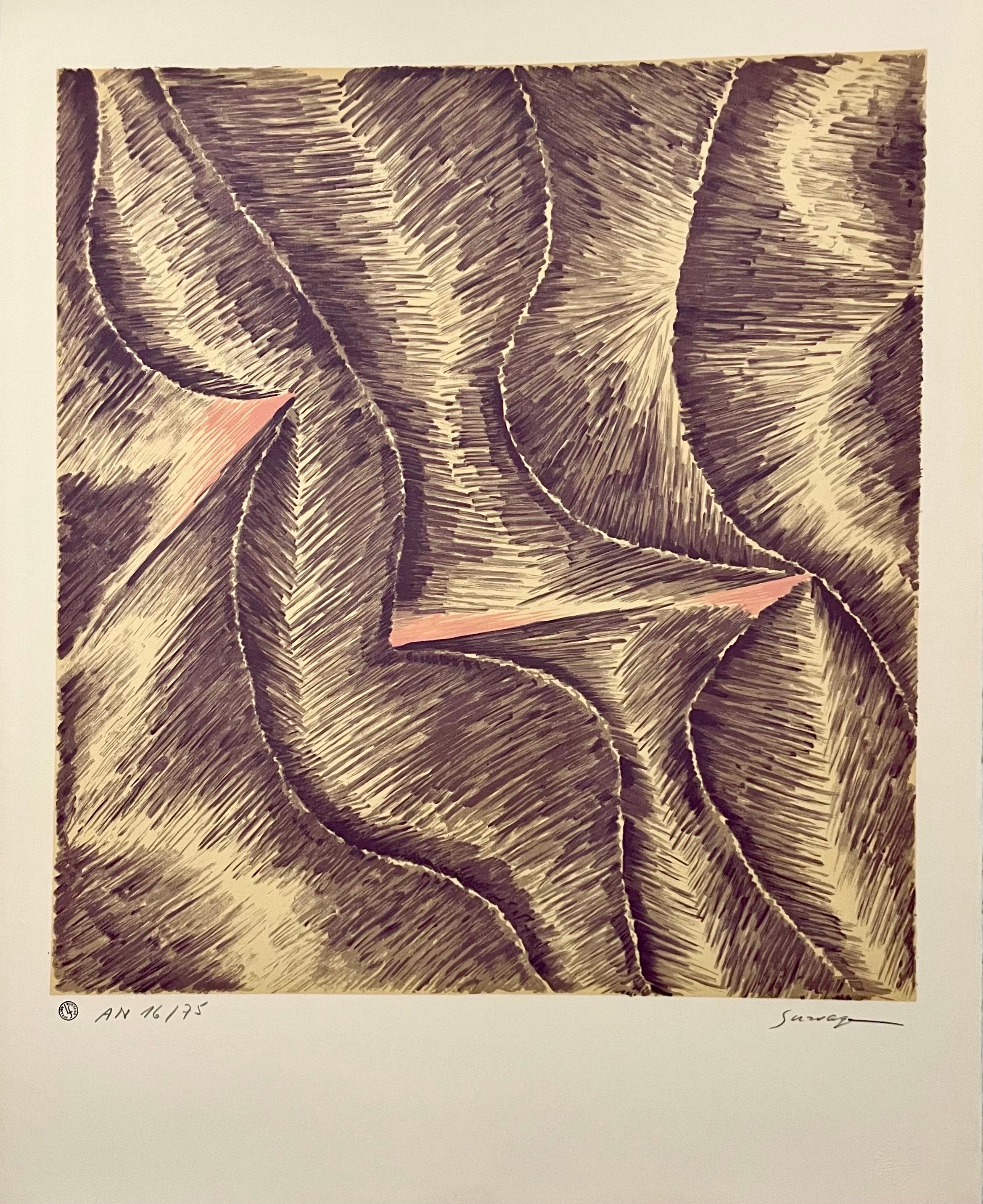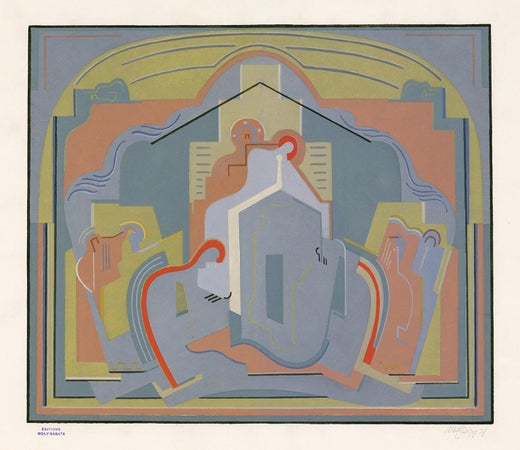Items Similar to 'Descente de Croix' (Descent from the Cross) — 1920s French Cubism
Want more images or videos?
Request additional images or videos from the seller
Albert Gleizes'Descente de Croix' (Descent from the Cross) — 1920s French Cubism1928
1928
About the Item
Albert Gleizes, 'Descente de Croix', color pochoir, 1928, edition c. 50. Signed and dated in pencil. A fine, painterly impression, with fresh colors, on heavy, cream wove paper; the full sheet with margins (3 to 4 inches), in very good condition. The publisher's ink stamp 'EDITIONS MOLY-SABATA' beneath the image, lower left. Matted to museum standards, unframed.
Image size 12 x 14 inches (305 x 356 mm); sheet size 18 x 22 inches (457 x 559 mm).
ABOUT THE IMAGE
After the 1927 painting 'Descente de Croix', one of three religious-themed works that Gleizes developed as preliminaries for murals at the church at Serrières, France, the project was terminated at its final phase, and Gleizes commissioned master printer Robert Pouyaud to create prints of the paintings, closely overseeing the production.
ABOUT THE MEDIUM
Pochoir is a refined stencil-based technique employed to create multiples or to add color to prints produced in other mediums. Characterized by its crisp lines and rich color, the print-making process was most popular from the late 19th century through the 1930s, with its center of activity in Paris. The pochoir process began with the analysis of an image’s composition, including color tones and densities. The numerous stencils (made of aluminum, copper, or zinc) necessary to create a complete image were then designed and hand-cut by the 'découpeur.' The 'coloristes' applied watercolor or gouache pigments through the stencils, skillfully employing a variety of different brushes and methods of paint application to achieve the desired depth of color and textural and tonal nuance. The pochoir process, by its handcrafted methodology, resulted in the finished work producing the effect of an original painting, and in fact, each print was unique.
ABOUT THE ARTIST
Albert Gleizes (1881-1953), born in Paris, France, was a pioneering figure in the development of abstract art and one of the leading proponents of Cubism. His contributions to the art world extended beyond his paintings; he was also a prolific writer and theoretician, advocating for a new approach to art that emphasized the geometric abstraction of form and a departure from representational traditions.
Gleizes initially studied painting at the Académie Julian and the École des Beaux-Arts in Paris, where he was exposed to the academic conventions of the time. However, his artistic vision was profoundly influenced by encounters with avant-garde movements, including Fauvism and the work of Paul Cézanne. These influences led Gleizes to experiment with form and color, gradually moving away from traditional representation toward a more abstract and geometric style.
After completing his secondary schooling, Gleizes spent four years in the French army and then began pursuing a career as a painter, primarily doing landscapes. Initially influenced by the Impressionists, he was only twenty-one years of age when his work titled ‘La Seine à Asnières’ was exhibited at the Société Nationale des Beaux-Arts in 1902. The following year, he was part of the first Salon d'Automne and soon came under the influence of Fernand Léger, Robert Delaunay, Jean Metzinger, and Henri Le Fauconnier. In 1907, Gleizes and some of his friends pursued the idea of creating a self-supporting community of artists that would allow them to develop their art free of any commercial concerns. For nearly a year, Gleizes , with other painters, poets, musicians, and writers, lived at a large house in Créteil, but a lack of funds forced them to give up their facility in early 1908, and Gleizes moved temporarily into La Ruche, the artist commune in the Montparnasse Quarter of Paris.
In the early 1910s, Gleizes became associated with the Cubist movement, which was spearheaded by artists such as Pablo Picasso and Georges Braque. Cubism sought to represent the multidimensional aspects of reality by breaking down forms into geometric shapes and exploring multiple perspectives within a single composition. Gleizes's contributions to Cubism were significant, as he co-authored the influential treatise "Du Cubisme" (On Cubism) with Jean Metzinger in 1912, outlining the principles and theories behind the movement.
With the outbreak of World War I, Albert Gleizes re-enlisted in the French army. He was put in charge of organizing entertainment for the troops and, as a result, was approached by Jean Cocteau to design the set and costumes for the William Shakespeare play, ‘A Midsummer Night's Dream.’ Discharged from the military in the fall of 1915, Gleizes and his new wife, Juliette Roche, the daughter of a prominent and wealthy French statesman, moved to New York City. From there, the couple sailed to Barcelona, Spain, where they were joined by Marie Laurencin, Francis Picabia, and his wife. The group spent the summer painting at the resort area of Tossa del Mar, and in December, Gleizes had the first solo exhibition of his works at the Galeries Dalmau in Barcelona. Returning to New York City, Gleizes began writing poetic sketches in verse and in prose. Traveling to Bermuda, he painted a number of landscapes, but when the war in Europe ended, he returned to France, where his career evolved into teaching through writing, and he became involved with the committee of the Unions Intellectuelles Françaises. In 1927, still dreaming of the communal days in Créteil, he founded an artist's colony at a rented house called the Moly-Sabata in Sablons near his wife's family home in Serrières in the Ardèche département in the Rhône Valley.
In 1931, Gleizes was part of the committee of Abstraction-Création that acted as a forum for international non-representational art. By this time, his work reflected the strengthening of his spiritual convictions, and his 1932 book, La Forme et l’histoire, examines Celtic, Romanesque, and Oriental art. On tour in Poland and Germany, he gave lectures titled Art et Religion, Art et Production, and Art et Science. In 1937, Gleizes was hired to paint murals for the Exposition Internationale des Arts et Techniques dans la Vie Moderne at the Paris World’s Fair. He collaborated with Delaunay in the Pavillon de l'Air and with Léopold Survage and Fernand Léger for the Pavillon de l'Union des Artistes Modernes. At the end of 1938, Gleizes volunteered to participate in the free seminars and discussion groups for young painters set up by Robert Delaunay at his Paris studio.
In the late 1930s, the wealthy American art connoisseur Peggy Guggenheim purchased a great deal of the new art in Paris, including works by Albert Gleizes. She brought these works to the United States, which today form part of the Peggy Guggenheim Collection. During World War II, Gleizes and his wife remained in France under the German occupation. His religious convictions deepened, and at the war's end, he was hailed by some as having laid out the principles for a renewal of religious art. In 1948, Gleizes accepted an offer from a publisher in Casablanca to create a series of etchings illustrating the ‘Pensées sur l'Homme et Dieu’ of Blaise Pascal. In 1951, he was made a jury member for the Prix de Rome, and the French government awarded him the Legion of Honor. In 1952, he completed his last major work, a fresco titled ‘Eucharist’ created for a Jesuit chapel in Chantilly.
Throughout his career, Gleizes remained dedicated to exploring the formal possibilities of abstraction while also incorporating elements of rhythm, color, and dynamic movement into his compositions. His style evolved over time, reflecting his ongoing engagement with modernist ideas and his interest in spirituality and metaphysics.
Albert Gelizes’ work is represented in numerous museums in the United States, the United Kingdom, and Europe including the British Museum (London), Los Angeles County Museum of Art, Musée d'Art Moderne de la Ville de Paris, Musée des Beaux-Arts de Lyon (Lyon, France), Musée de Grenoble (Grenoble, France), Musée National d'Art Moderne (Centre Georges Pompidou, Paris), Museum of Modern Art (New York), National Gallery of Art (Washington, D.C.), Peggy Guggenheim Collection (Venice, Italy), Solomon R. Guggenheim Museum (New York), The Metropolitan Museum of Art (New York), Philadelphia Museum of Art, Tate Modern (London).
- Creator:Albert Gleizes (1881-1953, French)
- Creation Year:1928
- Dimensions:Height: 12 in (30.48 cm)Width: 14 in (35.56 cm)
- Medium:
- Movement & Style:
- Period:
- Condition:
- Gallery Location:Myrtle Beach, SC
- Reference Number:
Albert Gleizes
Albert Gleizes (1881-1953) was a prominent French artist, theorist, and philosopher, best remembered as a pioneer of Cubism alongside artists like Picasso and Braque. Born in Paris, his early work was influenced by Impressionism, but by 1910, he had delved deep into the innovative world of Cubism, emphasizing geometrical forms and multiple viewpoints. With Jean Metzinger, he co-authored "On Cubism," a significant treatise that helped define and explain the movement's principles. Throughout his career, Gleizes continued to evolve his style, moving towards abstraction and integrating his fascination with rhythm and color. In addition to his visual contributions, his writings made him an influential voice in 20th-century art theory. A true visionary, Gleizes not only reshaped the art world with his creations but also laid the groundwork for future abstract artists with his profound insights into the essence of art.
About the Seller
5.0
Recognized Seller
These prestigious sellers are industry leaders and represent the highest echelon for item quality and design.
Platinum Seller
These expertly vetted sellers are 1stDibs' most experienced sellers and are rated highest by our customers.
Established in 1995
1stDibs seller since 2016
256 sales on 1stDibs
Typical response time: 1 hour
Associations
International Fine Print Dealers Association
- ShippingRetrieving quote...Ships From: Myrtle Beach, SC
- Return PolicyA return for this item may be initiated within 7 days of delivery.
More From This SellerView All
- Variation 4, Vol. IBy Katherine Sophie DreierLocated in Myrtle Beach, SCKatherine S. Dreier, 'Variation 4, Vol. I' from '1 to 40 Variations', lithograph with pochoir and hand-coloring, 1934, edition 65. Stenciled signature and date, lower right. Annotate...Category
Mid-20th Century American Modern Abstract Prints
MaterialsWatercolor, Lithograph, Stencil
- 'Variation 5, Vol. I' — from the series '1 to 40 Variations'By Katherine Sophie DreierLocated in Myrtle Beach, SCKatherine S. Dreier, 'Variation 5, Vol. I' from '1 to 40 Variations', lithograph with pochoir and hand-coloring, 1934, edition 65. Stenciled signature and date, lower right. Annotate...Category
Mid-20th Century American Modern Abstract Prints
MaterialsWatercolor, Lithograph, Stencil
- 'Nocturnal Adversary' — 1940s Surrealist AbstractionBy Edward August LandonLocated in Myrtle Beach, SCEdward Landon 'Nocturnal Adversary', color serigraph, 1946, edition 50, Ryan 137. Signed in pencil in the image, lower right. Titled, dated, and annotated '6 COLORS EDITION 50' in th...Category
1940s Surrealist Abstract Prints
MaterialsScreen
- Twin Formation in GrayBy Werner DrewesLocated in Myrtle Beach, SCTwin Formation in Gray, color woodcut, 1982, edition 30, Rose III.400. Signed, dated and numbered I7/XXX in pencil, annotated 415 and titled in the bottom left sheet edge. A fine imp...Category
Late 20th Century Bauhaus Abstract Prints
MaterialsWoodcut
- 'African Idol' — 1930s American ModernismBy Robert Vale FaroLocated in Myrtle Beach, SCRobert Vale Faro, untitled (African Idol), serigraph, c. 1940, edition 6. Signed in pencil. A fine impression, with fresh colors, on buff wove paper; the full sheet with margins(5/8 ...Category
1940s American Modern Abstract Prints
MaterialsScreen
- 'Signes' — Mid-Century Modernist AbstractionBy Jean (Hans) ArpLocated in Myrtle Beach, SCJean Arp, Signes, woodcut, edition 50, 1949. A fine, black impression, with all the fine lines printing clearly, on cream wove paper; the full sheet with wide margins (1 5/8 to 6 7/8 inches), in excellent condition. Signed and numbered '8/50' in pencil. Matted to museum standards, unframed. ABOUT THE ARTIST Jean Arp was born Hans Arp on September 16, 1886, in Strassburg. In 1904, after leaving the Ecole des Arts et Métiers, Strasbourg, he visited Paris and published his poetry for the first time. From 1905 to 1907, Arp studied at the Kunstschule, Weimar, and in 1908 went to Paris, where he attended the Académie Julian. In 1909, he moved to Switzerland and in 1911 was a founder of the Moderner Bund group there. The following year, he met Robert and Sonia Delaunay in Paris and Vasily Kandinsky in Munich. Arp participated in the Erste deutsche Herbstsalon in 1913 at the gallery Der Sturm, Berlin. After returning to Paris in 1914, he became acquainted with Guillaume Apollinaire, Max Jacob, Amadeo Modigliani, and Pablo Picasso. In 1915, he moved to Zurich, where he executed collages and tapestries, often in collaboration with his future wife Sophie Taeuber (who became known as Sophie Taeuber-Arp after they married in 1922). In 1916, Hugo Ball...Category
1940s Abstract Abstract Prints
MaterialsWoodcut
You May Also Like
- The Grape HarvestersBy Pablo PicassoLocated in London, GBPABLO PICASSO 1881-1973 Málaga 1881- 1973 Mougins (Spanish) Title: The Grape Harvesters Les Vendangeurs, 1959 Technique: Original Hand Signed and Numbere...Category
1950s Cubist Abstract Prints
MaterialsLinocut
- Still Life on a Table (Paris 1910)By Georges BraqueLocated in London, GBGEORGES BRAQUE 1882-1963 Argenteuil-sur-Seine, 1882-1963 Paris (French) Title: Still Life on a Table (Paris 1910) Nature morte sur une table (Paris 1910), 1910-11 Technique: Ori...Category
1910s Cubist Abstract Prints
MaterialsEtching
- Russian French Avant Garde Lithograph Rhythm in Colour Vibrant Abstract PrintBy Léopold SurvageLocated in Surfside, FLLéopold Survage (French/Russian, 1879-1968), "Rythmes Colorés", 1967-1968 Lithograph on Vélin d'Arches paper, Printed by Mourlot, Paris Hand signed in pencil and numbered "AN 16/75"...Category
1960s Cubist Abstract Prints
MaterialsLithograph
- Russian French Avant Garde Lithograph Rhythm in Colour Vibrant Abstract PrintBy Léopold SurvageLocated in Surfside, FLLéopold Survage (French/Russian, 1879-1968), "Rythmes Colorés", 1967-1968 Lithograph on Vélin d'Arches paper, Printed by Mourlot, Paris Hand signed in pencil and numbered "AN 16/75"...Category
1960s Cubist Abstract Prints
MaterialsLithograph
- Russian French Avant Garde Lithograph Rhythm in Colour Vibrant Abstract PrintBy Léopold SurvageLocated in Surfside, FLLéopold Survage (French/Russian, 1879-1968), "Rythmes Colorés", 1967-1968 Lithograph on Vélin d'Arches paper, Printed by Mourlot, Paris Hand signed in pencil and numbered "AN 16/75"...Category
1960s Cubist Abstract Prints
MaterialsLithograph
- Russian French Avant Garde Lithograph Rhythm in Colour Vibrant Abstract PrintBy Léopold SurvageLocated in Surfside, FLLéopold Survage (French/Russian, 1879-1968), "Rythmes Colorés", 1967-1968 Lithograph on Vélin d'Arches paper, Printed by Mourlot, Paris Hand signed in pencil and numbered "AN 16/75"...Category
1960s Cubist Abstract Prints
MaterialsLithograph
